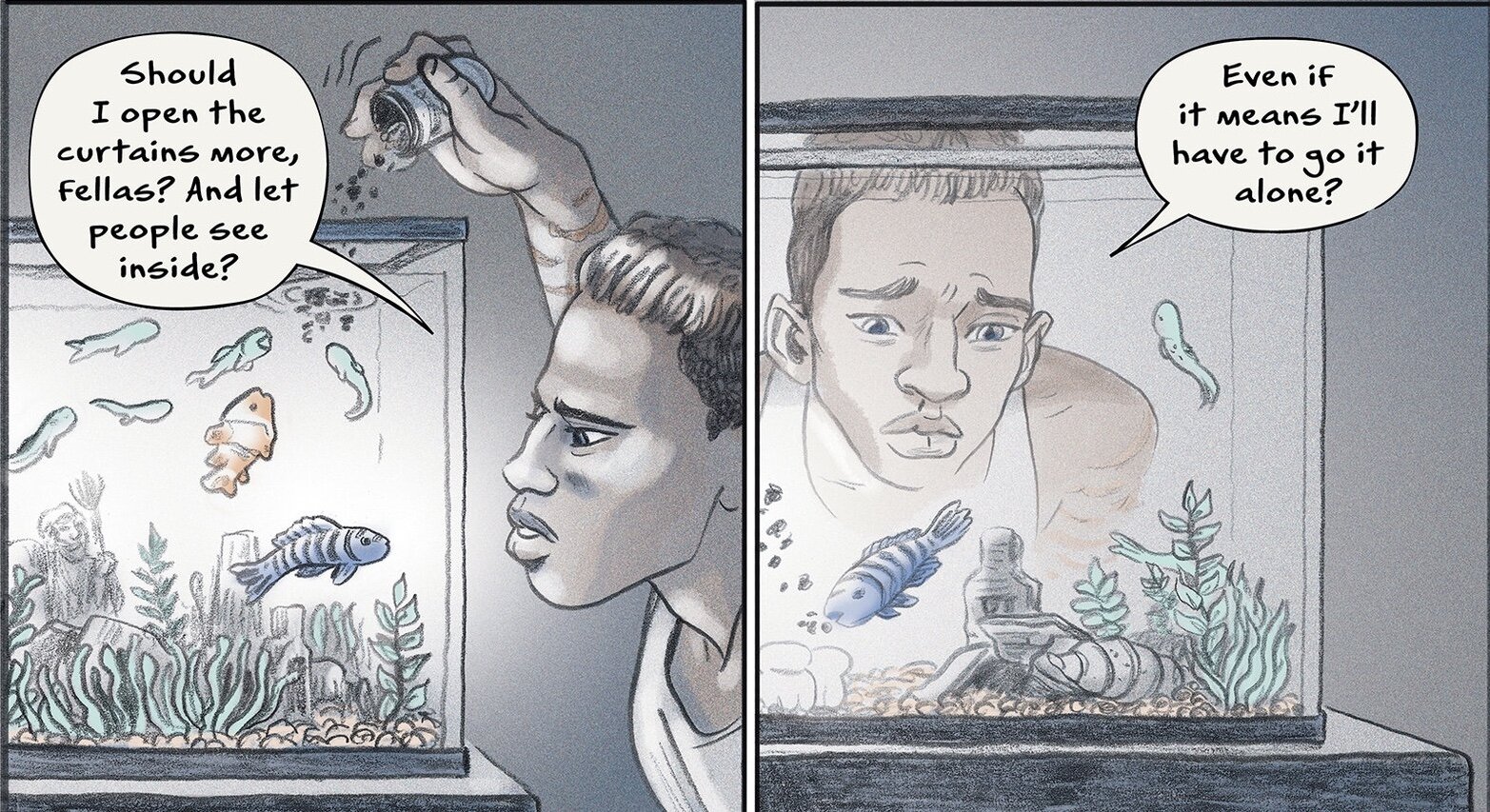You Brought Me the Ocean by Alex Sanchez and Julie Maroh is the coming-of-age tale of Jake Hyde, aka DC Universe superhero Aqualad. Born and raised in the desert city of Truth or Consequences, NM, Jake dreams of leaving to study oceanography and living next to the ocean; however, he struggles with telling his overprotective mom and best friend Maria this. To complicate matters, Jake also struggles with opening up about his sexuality to his mom and Maria, especially after becoming close to the charming, off-beat jock Kenny Liu.
What does the use of minimal coloring achieve in terms of storytelling?
It’s safe to say that one of the most iconic elements of comics is their colorfulness. This is particularly true because, popularly, comics are the realm of bold, colorful superheroes and bright, funny comic strips. The reputation is rightfully earned, and it is a testament to the deliberate choice on behalf of the creators to get their stories to stand out in a shelf full of other brightly clad superheroes. The deliberate use of color has been a part of the artistic process since time immemorial. The right hue, the right tone can illicit particular emotions in people, and this practice is plain to see across practically all forms of media, from painting to film. In graphic novels, the direction taken for the use of colors is a crucial element of that story’s identity and the story it seeks to tell.
Credit: Alex Sanchez & Julie Maroh
A five-panel page.
First panel: Truth and Consequences High School is set between towering dry, brown mountains and tall, green cacti. The sun is bright in the cloudless white sky.
Second panel: A large classroom, full of non-descript students and a teacher at the front. The scene is painted in light beige with only Jake’s hair and shirt colored teal and blue, Zeke’s hair colored red, and the green cacti outside the window.
Jake (narrating): Ms. Archer is my history teacher — my favorite teacher. She’s always encouraging us to be ourselves!
Ms. Archer: Franklin Roosevelt was a risk-taker—
Third panel: A close-up of Ms. Archer as she teaches. The panel is fully colored in the same light beige tone.
Ms. Archer: He les America out of the Great Depression and toward victory in World War Two.
Fourth panel: Kenny is raising his hand as he asks a question. Jake looks back at him, and Zeke and his friend stare at him quizzically from the back. Zeke’s bright red hair and Jake’s teal hair and blue shirt stand out in the panel.
Jake: Ms. Archer, can you talk about F.D.R’s wife? I read that Eleanor Roosevelt was a lesbian. Is that true?
Fifth panel: A close-up of Jake at his desk as he continues to look back at Kenny.
Jake (narrating): I’ve known Kenny since middle school. He’s always been outspoken in a way I wish I could be.
In You Brought Me the Ocean, color use is minimalistic, but why is that in a future superhero’s coming-out story? Shouldn’t it be colored in such bright, bold colors that the gay pride just jumps off the page? Well, not all stories start that way, and that is the story at hand. Jake’s story is one of frustration, repression, and isolation, and the dominant colors of the comic stress that even further. The way the panels are primarily colored in varying hues of reds and browns illicit in the reader the same dull, mind-numbing relationship Jake has with his hometown. These colors are eventually ambivalent, however, as the same tones are emblematic of the lionfish, whose Jake’s markings are inspired by. These markings and colors come to represent Jake’s power and pride.
Credit: Alex Sanchez & Julie Maroh
A two-panel set.
First panel: A close-up of Jake as he feeds his fish. The fish and their aquarium decorations are brightly colored in blues, greens, orange and brown. The light from the tank shone bright on Jake’s face.
Jake: should I open the curtains more, fellas? And let people see inside?
Second panel: A close-up of Jake seen through the brightly colored aquarium. His face is illuminated by the tank as he stares sadly at his fish.
Jake: Even if it means I’ll have to go it alone?
The only other colors used in the story are blues and greens, seen in the cacti decorating the landscape, in Jake’s aquarium and, most importantly, in Kenny’s hair and clothes. These colors are shorthand for water, the thing that Jake desires more than anything else. By extension, water is a symbol of life, both at its most basic definition but also in the sense of enriching experiences. In this dull landscape, blues and greens are a siren song to Jake beckoning him to take the plunge and embrace his desires. All of this is personified by Kenny, but it is important to notice that while Kenny represents water, he does not represent the ocean. He is the embodiment of desert water — springs, rivers, rain — replenishing and restorative but part of this specific landscape. Unlike Jake, his place is here.

